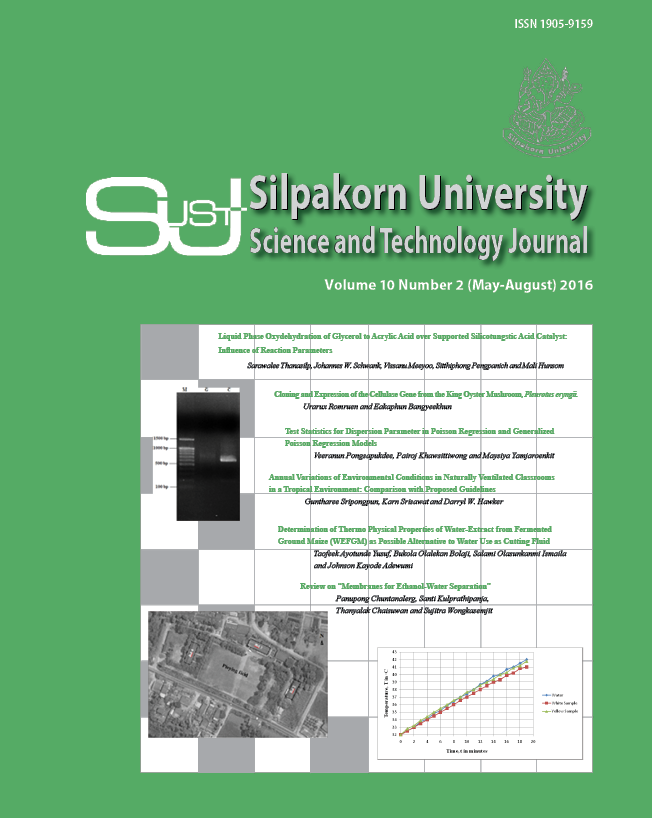Cloning and Expression of the Cellulase Gene from the King Oyster Mushroom, Pleurotus eryngii
Main Article Content
Abstract
A gene encoding for cellobiohydrolase (PEcbh) from P. eryngii was cloned by using RT-PCR 3’ and 5’ RACE techniques. The result showed that the PEcbh was 1377 bp nucleotide sequence encoded for 459-deduced amino acid. Analysis of predicted protein revealed that PEcbh consisted of a glycosyl hydrolase family 7 domain but lacked of cellulose binding domain, a calculated molecular weight of 49.3 kDa and a pI of 5.3. The PEcbh was cloned into pET28a (+) to obtain a recombinant pET/PEcbh and expressed in E. coli BL21 (DE3). The optimal conditions of PEcbh expression were 0.2 mM IPTG, 1 h induction time at 180C and 4 h post-induction time. The CMCase activity could be detected, but at a low activity. This is probably due to a lack of the cellulose binding domain in PEcbh. Expression of PEcbh in E. coli BL21 (DE3) and Rosetta (DE3) were compared and the results indicated that CMCase activity in Rosetta (DE3) was higher than in BL21 about 2 times.
Downloads
Article Details
References
Ding, S., Ge, W., and Buswell, J. A. (2006). Cloning of multiple cellulase cDNA from Volvariella volvacea and their differential expression during substrate colonization and fruiting. Federation of European Microbiological Societies, 263: 207-213.
Geng, A., Zou, G., Yan, X., Wang, Q., Zhang, J., Liu, F., Zhu, B., and Zhou, Z. (2012). Expression and characterization of a novel metagenome-derived cellulase Exo2b and its application to improve cellulase activity in Trichoderma reesei. Applied Microbiology Biotechnology, 96(4): 951-962.
Gilkes, N. R., Henrissat, B., Kilburn, D. G., Miller, R. C., Jr., and Warren, R. A. J. (1991). Domains in microbial β-1,4-glycanases: sequence conservation, function, and enzyme families. American Society for Microbiology, 55(2): 303-315.
Gyorfi, J., and Hajdu, C. S. (2007). Casing-material experiments with Pleurotus eryngii. International Journal of Horticultural Science, 13(2): 33-36.
Henriksson, G., Salumets, A., Divne, C., and Pettersson, G. (1997). Studies of cellulose binding by cellobiose dehydrogenase and a comparison with cellobiohydrolase I. Biochemical Journal, 324: 833-838.
Hou, Y., Wang, T., Long, H., and Zhu, H. (2007). Cloning, sequencing and expression analysis of the first cellulase gene encoding cellobiohydrolase I from a cold-adaptive Penicillium chrysogenum FS010. Acta Biochimica et Biophysica Sinica, 39(2): 101-107.
Irwin, D., Shin, D. H., Zhang, S., Barr, B. K., Sakon, J., Karplus, P. A., and Wilson, D. B. (1998). Roles of the catalytic domain and two cellulose binding domains of Thermomonospora fusca E4 in cellulose hydrolysis. Journal of Bacteriology, 180(7): 1709-1714.
Jia, J., Dyer, P. S., Buswell, J. A., and Peberdy, J. F. (1999). Cloning of cbhI and cbhII genes involved in cellulose utilization by the straw mushroom Volvariella volvacea. Molecular Genetics, 261: 985–993.
Kuforiji, O. O. and Fasidi, I. O. (2008). Enzyme activities of Pleurotus tuber-regium (Fries) singer, cultivated on selected agricultural wastes. Bioresource Technology, 99: 4275-4278.
Kwon, I., Ekino, K., Goto, M., and Furukawa, k. (1999). Heterologous expression and characterization of endoglucanase I (EGI) from Trichoderma viride HK-75. Louisiana Bar, 63(10): 1714-1720.
Lee, C. C., Wong, D. W. S., and Robertson, G. H. (2001). Cloning and characterization of two cellulase genes from Lentinula edodes. Federation of European Microbiological Societies, 205: 355-360.
Lui, J. and Hu, H. (2012). The role of cellulose binding domains in the adsorption of cellulases onto fibers and its effect on the enzymatic beating of bleached kraft pulp. BioResource, 7(1): 878-892
Mathew, G. M., Sukumaran, R. K., Singhania R. R., and Pandey, A. (2008). Progress in research on fungal cellulases for lignocellulose degradation. Journal of Scientific & Industrial Research, 67: 898-907.
Muller, U., Tenberge, K. B., Oeser, B., and Tudzynski, P. (1997). Cel1, Probably encoding a cellobiohydrolase lacking the substrate binding domain, is expressed in the initial infection phase of Claviceps purpurea on Secale cereale. The American Phytopathological Society, 10(2): 268-279.
Nidetzky, B., Steiner, W., and Claeyssens, M. (1994). Cellulose hydrolysis by the cellulases from Trichoderma reesei: Adsorptions of two cellobiohydrolases, two endocellulases and their core proteins on filter paper and their relation to hydrolysis. Biochemical Journal, 303: 817-823.
Ohga, S. and Royse, D. J. (2004). Cultivation of Pleurotus eryngii on umbrella plant (Cyperus alternifolius) substrate. The Japan Wood Research Society, 50:466-469.
Rodriguez Estrada, A.E., and Royse, D.J. (2007). Yield, size and bacterial blotch resistance of Pleurotus eryngii grown on cottonseed hulls/oak sawdust supplemented with manganese, copper and whole ground soybean. Bioresource Technology, 98: 1898-1906.
Sánchez, C. (2009) Lignocellulosic residues: Biodegradation and bioconversion by fungi. Biotechnology Advances, 27(2): 185-194.
Shimada, M. and Takahashi, M. (1991). Biodegradation of cellulosic materials. In Wood and cellulosic chemistry (Hon, D. N. S. and Shiraishi, N., eds.), pp. 621-633. New York: Marcel Dekker Inc.
Somogyi, M. (1952). Notes on sugar determination. The Journal of Biological Chemistry, 195: 19-23.
Stahlberg, J., Johansson, G., and Pettersson, G. (1991). A new model for enzymatic hydrolysis of cellulose based on the two-domain structure of cellobiohydrolase I. Nature Biotechnology, 9: 286-290.
Stamets, P. (1993) Growing gourmet and medicinal mushrooms, 3rd ed., California: Ten speed Press, pp. 301-304.
Taipakova, S., Smailov, B., Stanbekova, G., and Bissenbaev, A. (2011). Cloning and expression of Lentinula edodes cellobiohydrolase gene in E. coli and characterization of the recombinant enzyme. Journal of Cell and Molecular Biology, 9(1): 53-61.
Tegel, H., Ottosson, J., and Hober, S. (2011). Enhancing the protein production levels in Escherichai coli with a strong promoter. The FEBS Journal, 278: 729-739.
Terpe, K. (2006). Overview of bacterial expression systems for heterologous protein production: from molecular and biochemical fundamentals to commercial systems. Apply Microbiology Biotechnology, 72: 211-222.
Xue, G. P., Orpin, C. G., Gobius, K. S., Aylward, J. H., and Simpson, G. D. (1992). Cloning and expression of multiple cellulase cDNAs from the anaerobic rumen fungus Neocallimastix patriciarum in Escherichia coli. Journal of General Microbiology, 138: 1413-1420.


